2 December 2024 : Daily Current Affairs
1. In our fight against climate change, could the seas turn the tide?
(Source – The Hindu, International Edition – Page No. – 7)
| Topic: GS3 – Environment – Climate change |
| Context |
● The oceans, vital for moderating Earth’s climate, have absorbed 25% of anthropogenic CO₂ emissions and 90% of excess heat. However, this comes at a cost, including acidification and ecological disruptions.
|
Role of Oceans in Climate Moderation
- Oceans have absorbed 25% of anthropogenic carbon dioxide emissions and more than 90% of excess heat from greenhouse gases.
- This process has bought humanity critical time to combat climate change.
- However, it comes with consequences, including ocean acidification, disrupted biogeochemical cycles, and harm to marine ecosystems.
- Acidification threatens calcifying organisms, while warming disrupts ocean circulation and deoxygenates habitats, undermining vital ecosystem services like fisheries and carbon sequestration.
Marine Carbon Dioxide Removal (mCDR): An Emerging Focus
- Oceans offer immense potential for carbon removal due to their large surface area and unique chemistry.
- Unlike land, which has reached a saturation point for carbon capture, oceans present untapped opportunities for sequestration.
- Marine carbon capture strategies fall into two categories:
- Biotic Approaches: Leverage living systems like mangroves and macroalgae for carbon sequestration.
- Abiotic Approaches: Use chemical and physical processes, such as ocean alkalinity enhancement (OAE).
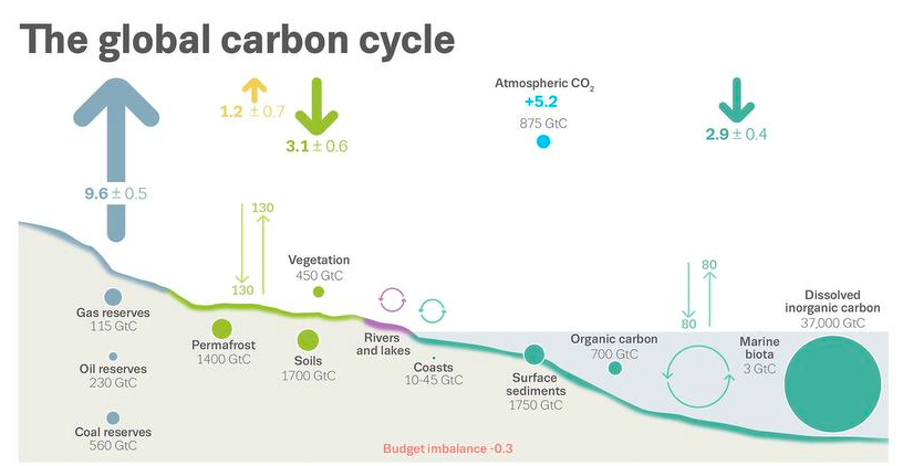
Biotic Solutions: Nature-Based Approaches
- These approaches rely on ecosystems to sequester carbon while promoting biodiversity and coastal protection.
- They are modest in capacity, sequestering less than one billion tonnes of CO₂ annually with storage lasting hundreds to thousands of years.
- Some biotic methods are already integrated into national climate plans.
Abiotic Solutions: Technological Approaches
- Abiotic methods offer greater scalability and permanence:
- Biomass burial can sequester 7-22 billion tonnes of CO₂ per year.
- OAE can neutralize seawater’s CO₂, potentially capturing 1-15 billion tonnes annually and storing it for tens of thousands of years.
- These methods face challenges, including public scepticism, regulatory hurdles, and energy-intensive processes.
Challenges and Risks
- Techniques like ocean iron fertilization and macroalgae cultivation can disrupt ecosystems and alter water chemistry.
- Measuring and monitoring carbon burial in oceans is expensive and complex.
- Public perception often favors biotic over abiotic solutions, further complicating deployment.
The Path Forward
- mCDR is not a replacement for emissions reduction but complements efforts toward net-zero emissions.
- Robust governance, societal trust, and rigorous science are crucial for success.
- The Indian Ocean holds significant promise for deep carbon burial, potentially capturing 25-40% of marine CO₂, providing a critical edge against global warming.
| PYQ: Bring out the relationship between the shrinking Himalayan glaciers and the symptoms of climate change in the Indian sub-conSnent. (150 words/10m) (UPSC CSE (M) GS-1 2014) |
| Practice Question: Discuss the potential and challenges of Marine Carbon Dioxide Removal (mCDR) in mitigating climate change. How can India leverage its vast coastline and the Indian Ocean to achieve climate goals? (250 Words /15 marks) |
2. What India’s AI Safety Institute could do
(Source – The Hindu, International Edition – Page No. – 9)
| Topic: GS2 – Governance, GS3 – Science and Technology |
| Context |
| ● India’s Ministry of Electronics and Information Technology is planning to establish an AI Safety Institute to address risks associated with artificial intelligence.
● The initiative aligns with international AI governance efforts like the Global Digital Compact and Bletchley Process. India’s leadership can advocate for inclusive, evidence-based AI policy, benefiting both domestic and global ecosystems. |
Background of AI Safety Initiative in India
- The Ministry of Electronics and Information Technology (MeitY) initiated discussions in October on establishing an AI Safety Institute under the IndiaAI Mission.
- This move follows global dialogues on AI governance, including the Quad Leaders’ Summit and the United Nations Summit of the Future.
- The Global Digital Compact, adopted at the Summit of the Future, highlights multi-stakeholder collaboration, human-centric oversight, and inclusive participation as key principles for AI governance.
- India’s leadership at the G20 and the Global Partnership on AI (GPAI) positions it to play a unifying role in global AI governance.
Designing the AI Safety Institute
- The proposed AI Safety Institute should focus on building domestic capacity and aligning with international AI safety initiatives like the Bletchley Process.
- The institute should prioritize research, testing, and standardization while avoiding prescriptive regulatory controls, as seen in the European Union (EU) and China.
- Regulatory sanctions in evolving ecosystems could discourage proactive information sharing and limit innovation.
- Instead, India should separate institution building from regulation-making to maximize the institute’s effectiveness.
| Global Precedents for AI Safety Institutes |
| ● The U.K., U.S., and other nations have established AI Safety Institutes focused on assessing frontier AI risks related to cybersecurity, biosphere safety, and national security.
● These institutes foster collaboration between governments, AI labs, and multi-stakeholder groups for third-party risk assessments and proactive information sharing. ● They aim to mainstream risk mitigation practices and provide evidence-based insights for AI governance. ● The Bletchley network of safety institutes offers India an opportunity for global collaboration on AI safety. |
India’s Approach to AI Safety
- India should establish its AI Safety Institute as a technical research and testing body, independent of rulemaking and enforcement.
- The institute can tap into international expertise through the Bletchley network while addressing domestic AI governance needs.
- It should focus on risks like bias, discrimination, social exclusion, gendered impacts, labor markets, privacy, and data collection.
- The institute could contribute to global dialogues on AI harm mitigation, standardization, and forward-thinking governance.
Potential Benefits
- India’s AI Safety Institute could enhance global collaboration, improve domestic oversight, and advocate for developing countries’ perspectives in AI governance.
- By adopting a scientific, evidence-based approach, India can position itself as a global leader in inclusive and proportionate AI policy solutions.
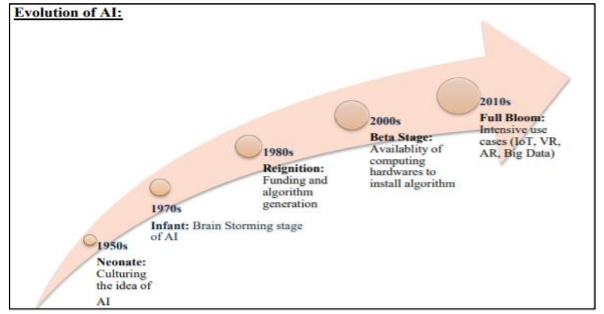
| Practice Question: Discuss the significance of establishing an AI Safety Institute in India in the context of global AI governance. Highlight how such an institute can address domestic challenges and contribute to international collaborations. (150 Words /10 marks) |
3. Controversy Surrounding Ajmer Sharif Dargah: Historical Legacy and Communal Harmony Under Scrutiny
(Source: Indian Express; Section: Explained; Page: 09)
| Topic: GS1 – History |
| Context: |
|
Analysis of News:
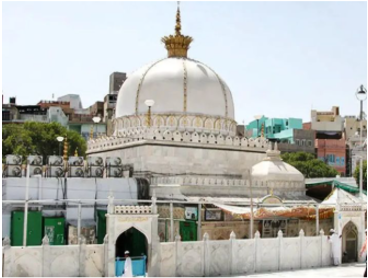
Historical Context of Ajmer and the Dargah
- Ajmer, historically known as Ajaymeru, was established in the 12th century by Ajaydeva of the Chauhan dynasty.
- It flourished as their capital until the Second Battle of Tarain in 1192, when Muhammad of Ghor’s forces sacked the city.
- For centuries, Ajmer remained in decline until its revival under the Mughal emperor Akbar, who was a frequent visitor and supporter of the shrine.
- The Ajmer Sharif Dargah, dedicated to Khwaja Moinuddin Chishti, became a symbol of communal harmony and spiritual significance.
Development and Evolution of the Dargah
- Initially, the Khwaja’s resting place had no formal tomb, but by the 15th century, the Khalji rulers of Malwa constructed the first mausoleum and the Buland Darwaza.
- The shrine saw significant expansions during the Mughal period, particularly under Akbar, who visited frequently and encouraged further development.
- Notable contributions included the Akbari Masjid, lattice railings by Jahangir, and architectural enhancements by Shah Jahan.
Sufi Legacy of Khwaja Moinuddin Chishti
- Born in 1141 in Sistan (modern-day Iran), Moinuddin Chishti epitomized Sufism’s inclusive and mystical spirit. After extensive theological studies and spiritual mentorship under Khwaja Usman Harooni, he traveled to India, finally settling in Ajmer in 1191.
- Renowned for his compassion and service to the poor, he earned the title Gharib Nawaz (friend of the poor).
- His teachings emphasized tolerance and the synthesis of diverse spiritual traditions, drawing reverence from Hindus and Muslims alike.
Architectural and Cultural Significance
- The architecture of the dargah reflects a blend of Islamic and local styles, with elements believed to be repurposed from earlier Hindu and Jain structures.
- The petition requesting a survey of the dargah claims that it was built on demolished temples, citing historical accounts like those of Har Bilas Sarda. However, these accounts also highlight the inclusive legends surrounding the shrine, such as Khwaja’s mystical interaction with Lord Shiva, which fostered cross-religious veneration.
Contemporary Relevance and Communal Harmony
- Ajmer Sharif Dargah remains a vital symbol of unity, attracting pilgrims of all faiths.
- The current petition, which alleges a controversial origin for the shrine, risks rekindling historical grievances that could threaten the communal harmony the dargah represents.
- The legacy of Khwaja Moinuddin Chishti serves as a reminder of India’s pluralistic traditions, emphasizing tolerance over division.
| About Sufism |
Other major Sufi Orders in India: Suhrawardi Order:
Naqshbandi Order:
The Qadri order
|
| Practice Question: Discuss the historical significance and spiritual legacy of the Ajmer Sharif Dargah and analyze the implications of contemporary claims on its origins for communal harmony in India. (250 words/15 m) |
4. Supreme Court Ruling Mandates Prior Sanction for Public Servants in Money Laundering Cases
(Source: Indian Express; Section: Explained; Page: 09)
| Topic: GS2 – Polity |
| Context: |
|
Analysis of News:
Background of the Issue
- The recent Supreme Court (SC) ruling mandates that prior government sanction is required to prosecute public servants under money laundering charges, as per Section 197 of the Code of Criminal Procedure (CrPC).
- This precedent is being cited by political figures like Arvind Kejriwal and P. Chidambaram to seek a stay on their respective trials in money laundering cases.
Provision for Prior Sanction
- Section 197 of CrPC protects public servants by barring courts from taking cognisance of offences committed in the discharge of official duties without prior government approval.
- Similarly, Section 19 of the Prevention of Corruption Act (PCA) and Section 218 of the Bharatiya Nagarik Suraksha Sanhita (BNSS) echo this safeguard.
- The intent is to prevent frivolous or politically motivated prosecution while ensuring accountability for serious misconduct.
Recent Supreme Court Verdict
- On November 6, the SC extended the applicability of prior sanction under Section 197 CrPC to the Prevention of Money Laundering Act (PMLA).
- The court reasoned that PMLA provisions align with CrPC requirements and upheld a Telangana High Court order that quashed proceedings against two IAS officers due to the absence of prior sanction.
- This decision reinforces the principle that criminal acts must have a nexus with official duties to claim such protection.
Implications for Public Servants
- The requirement of prior sanction can impact ongoing and future PMLA cases involving public servants.
- Chargesheets or convictions without sanction may be challenged and potentially overturned.
- This adds another layer of scrutiny to ED investigations, requiring closer adherence to procedural safeguards.
Challenges and Controversies
- Critics argue that this provision could delay justice and provide undue protection to corrupt officials.
- On the other hand, proponents view it as essential to prevent misuse of investigative powers.
- In politically sensitive cases like those involving Kejriwal and Chidambaram, it underscores the balance between accountability and safeguarding officials from harassment.
Conclusion
- The SC’s interpretation highlights the importance of procedural safeguards while prosecuting public servants under PMLA.
- The ruling has significant ramifications for the legal landscape surrounding anti-corruption and money laundering laws, potentially altering how agencies like the ED proceed against public officials.
| What is Money Laundering? |
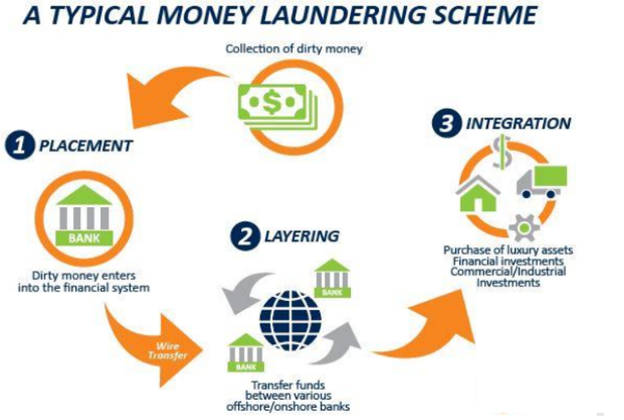
Money laundering is the illegal process of making large amounts of money generated by criminal activity, such as drug trafficking or terrorist funding, appear to have come from a legitimate source.
Prevention of Money Laundering Act (PMLA) 2002
Provisions:
|
| Practice Question: Examine the Supreme Court’s recent ruling on the requirement of prior sanction for prosecuting public servants under the Prevention of Money Laundering Act (PMLA). What implications does it have for ongoing trials involving public servants? (250 words/15 m) |
PRELIMS FACTS
1. Twice-Yearly Injectable Lenacapavir: A Game-Changer in HIV Prevention with 100% Efficacy
(Source: Indian Express; Section: The World)
| Context: |
|
Analysis of News:
Introduction
- Lenacapavir, a twice-yearly injectable drug for HIV prevention, marks a significant breakthrough in public health.
- Data from the PURPOSE 1 trial, presented at the 25th International AIDS Conference (AIDS 2024) and published in The New England Journal of Medicine, highlights its potential as a transformative solution for HIV prevention.
Efficacy and Trial Design
- The PURPOSE 1 trial, a Phase 3 double-blind, randomized study, enrolled 5,345 cisgender adolescent girls and young women aged 16-26 from South Africa and Uganda.
- Lenacapavir demonstrated 100% efficacy, with no HIV infections observed in the treatment group, setting a new benchmark in HIV prevention.
- The trial emphasized person-centered approaches and inclusivity, ensuring reliable and comprehensive results.
Safety and Accessibility
- Lenacapavir was found to be safe and well-tolerated. However, accessibility and affordability remain critical challenges.
- UNAIDS highlighted the need for price reductions, estimating a generic version could cost as low as $40 per year.
Future Prospects
- Results from the ongoing PURPOSE 2 trial, expected in late 2024/early 2025, will assess lenacapavir’s efficacy among cisgender men, transgender individuals, and non-binary populations across multiple countries.
- If approved, lenacapavir could become a cornerstone in global HIV prevention strategies, accelerating progress toward ending the epidemic.
Global Implications
- Experts emphasized the potential of lenacapavir to revolutionize HIV prevention if delivered affordably and equitably.
- The study’s success is credited to the thousands of volunteers, showcasing the power of collaboration between science and community engagement.
2. Trump threatens 100% tariffs on BRICS if dollar is undermined
(Source – The Hindu, International Edition – Page No. – 1)
| Context |
| ● The U.S. dollar’s dominance in global trade is being challenged by BRICS nations, which aim to reduce reliance on it.
● In response, Donald Trump has threatened 100% tariffs if these countries promote alternatives or develop a BRICS currency. |
Trump’s Tariff Threat Against BRICS
- S. President-elect Donald Trump has threatened 100% tariffs on nine BRICS alliance nations if they undermine the U.S. dollar.
- The BRICS alliance includes Brazil, Russia, India, China, South Africa, Egypt, Ethiopia, Iran, and the UAE.
- Trump demands these countries avoid creating a new BRICS currency or supporting alternatives to the U.S. dollar.
The Dollar’s Global Dominance
- The U.S. dollar remains the dominant global currency, comprising 58% of global foreign exchange reserves (IMF data).
- Most global commodities, like oil, are primarily traded in dollars.
- However, BRICS nations aim to trade in non-dollar currencies, challenging the dollar’s dominance.
Russia’s Push for Alternatives
- Russian President Vladimir Putin criticized the U.S. for “weaponising” the dollar at a BRICS summit.
- Russia advocates for an alternative payment system to bypass SWIFT and counter Western sanctions.
Future of the Dollar
- Despite challenges, research suggests the U.S. dollar’s role as the global reserve currency is secure in the near future.
3. Plastic treaty negotiations fail with countries split over production cuts
(Source – The Hindu, International Edition – Page No. – 1)
| Context |
| ● Representatives from 170 countries convened in Busan, South Korea, for the fifth round of the Intergovernmental Negotiations Committee (INC) discussions aimed at eliminating plastic pollution.
● Despite a week of talks, the countries failed to agree on a framework due to stark divisions over critical issues. ● Negotiations will resume under the banner of INC-5.2, likely in the coming year. |
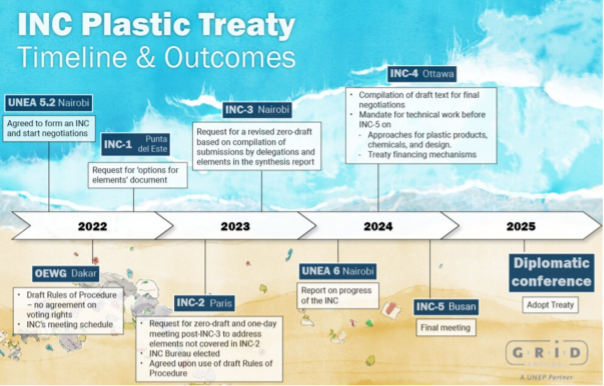
Divisions on Reducing Plastic Production
- The talks highlighted disagreements between countries advocating for a reduction in virgin plastic polymer production and those opposing it.
- Some nations with petrochemical-dependent economies opposed setting production reduction targets, citing significant economic implications.
- Others argued that regulating plastic production impacts their developmental rights and economic growth prospects.
Limited Progress and Future Steps
- A synthesized text, intended to create a consensus, failed to address the concerns of all nations.
- Delegates expressed collective disappointment at the limited progress and the inability to reach a compromise.
- Countries remain committed to continuing negotiations in the future to address unresolved issues.
Concerns Over Broader Agendas
- Some countries like Qatar, criticized the discussions, alleging they served as a pretext for advancing trade restrictions, economic agendas, and commercial competition under the guise of environmental action.
4. Shock diamonds: supersonic heat nuggets
(Source – The Hindu, International Edition – Page No. – 7)
| Context |
| ● Shock diamonds, or Mach diamonds, are bright and dark patterns in the exhaust plume of supersonic rockets or jets, formed due to pressure differences between exhaust and atmospheric pressure.
● These patterns result from repeated compression and expansion cycles. |
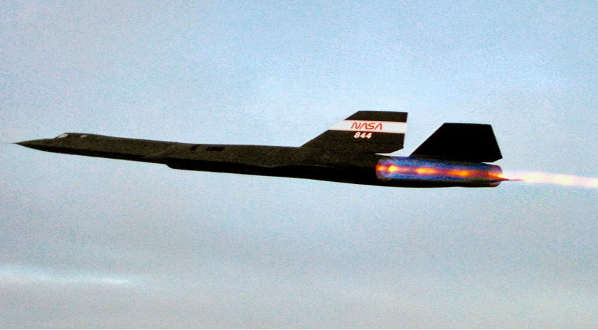
Shock Diamonds Explained
- Definition: Shock diamonds, also known as Mach diamonds, are alternating light and dark patterns visible in the exhaust plume of a rocket or jet engine operating at supersonic speeds.
- Formation:
- Occurs when the exhaust pressure differs from the surrounding atmospheric pressure.
- Exhaust undergoes compression and expansion cycles as it equalizes with atmospheric pressure.
- These cycles create waves in the exhaust plume.
- Bright Spots:
- Atmospheric compression increases exhaust pressure, causing temperature to rise.
- Fuel burns in these high-pressure regions, creating bright spots called shock diamonds.
- Process:
- Exhaust bends inward under atmospheric pressure and outward due to over-compression.
- Repeated cycles form a visible shock diamond pattern in the plume.



